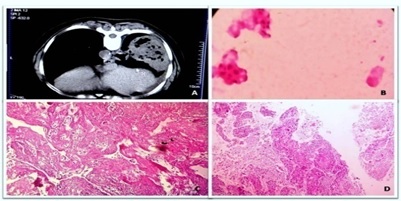A clinicopathological study of pleural effusion with special reference to malignant aetiology in a tertiary care hospital in West Bengal
Abstract
Background: Pleural effusion has varied aetiological factors. It constitutes one of the major causes of morbidity in India as well in other parts of world. Because of the various aetiologies that can cause pleural effusion, itoften present a diagnostic problem, even after extensive investigations.
Objective: In this study, authors aimed to identify the common aetiologies causing pleural effusion and their clinical profile in a tertiary care hospital.
Materials and Methods: A hospital based cross-sectional study is conducted over a period of one year in tertiary care hospital in West Bengal. 150 patients of pleural effusion above 10 yrs of age were studied. Clinico-pathological, radiological, hematological and biochemical parameters were documented.
Results: The most common cause pleural effusion in this study was tuberculosis (64.67%), followed by malignancy (14.67%), parapneumonic effusion (7.33%), cardiac failure (5.33%) and other minor causes. It was commonly seen in male (70%). The occurrence of tubercular pleural effusion was maximum in the age group 31-40 years. Right-sided effusions were more common. Pleural fluid cytology and adenosine deaminase played a pivotal role in the diagnosis of tubercular pleural effusion.
Conclusion: The present study highlights tuberculosis as the common causative factor for pleural effusion, labels lung carcinoma as the most common cause of malignant pleural effusion, and defines the clinico-pathological, biochemical and imaging characteristics of different aetiologies of pleural effusion.
Downloads
References
Wong CL, Holroyd-Leduc J, Straus SE. Does this patient have a pleural effusion? JAMA. 2009;301 (3): 309-17. DOI: 10.1001/jama.2008.937.
Light RW. Clinical practice. Pleural effusion. N Engl J Med. 2002;346(25):1971-7. DOI:10.1056/NEJMcp 01 0731
Marel M, Zrůtová M, Štasny B, Light RW. The incidence of pleural effusion in a well-defined region. Epidemiologic study in central Bohemia. Chest. 1993; 104 (5):1486-9. DOI:10.1378/chest.104.5.1486
Afful B, Murphy S, Antunes G, Dudzevicius V. The characteristics and causes of pleural effusions in Kumasi Ghana - a prospective study. Trop Doct. 2008; 38(4):219-20. DOI: 10.1258/td.2007.070275.
Koffi N, Aka-Danguy E, Kouassi B, Ngom A, Blehou DJ [Etiologies of pleurisies in African milieu. Experience of the Cocody Pneumology department (Abidjan-Côte d'Ivoire)]. Rev Pneumol Clin. 1997;53 (4):193-6. DOI: RP-10-1997-53-4-0761-8417-101019-ART67
Al-Qorain A, Larbi EB, Al-Muhanna F, Satti MB, Baloush A, Falha K.. Pattern of pleural effusion in Eastern Province of Saudi Arabia: a prospective study. East African Medical Journal, 1994;71(4):246–249.
Al-Alusi F. Pleural effusion in Iraq: a prospective study of 100 cases. Thorax. 1986;41(6):492-3. DOI: 10.1136/thx.41.6.492
Heffner JE, Klein JS. Recent advances in the diagnosis and management of malignant pleural effusions. Mayo Clin Proc. 2008;83(2):235-50. DOI: 10.4065/83.2.235.
Azzopardi M, Porcel JM, Koegelenberg CF, Lee YC, Fysh ET. Current controversies in the management of malignant pleural effusions. Semin Respir Crit Care Med. 2014;35(6):723-31.DOI: 10.1055/s-0034-1395795
Fitzgerald DB, Koegelenberg CFN, Yasufuku K, Lee YG. Surgical and non-surgical management of malignant pleural effusions. Expert Rev Respir Med. 2018; 12(1):15-26. DOI: 10. 1080/17476348. 2018. 1398085.
Jindal SK. Textbook of Pulmonary and Critical Care Medicine. 1st ed., Vol. 2. New Delhi: Jaypee Brothers Medical Publishers (P) Ltd.; 2011.
Valdes L, Alvarez D, Valle JM, Pose A, San Jose E. The etiology of pleural effusions in an area with high incidence of tuberculosis. Chest. 1996;109(1):158-62. DOI:10.1378/chest.109.1.158
Maikap MK, Dhua A, Maitra MK. Etiology and clinical profile of pleural effusion. Int J Med Sci Pub Health. 2018;7(4):316-22. DOI: 10.5455/ijmsph.2018.0 101931012018
Light RW. Clinical manifestations and useful tests. Pleural Dis. 1995;10(4):42-86. DOI: 10.1183/09031936. 97.10020476
Chinchkar NJ, Talwar D, Jain SK. A stepwise approach to the etiologic diagnosis of pleural effusion in respiratory intensive care unit and short-term evaluation of treatment. Lung India. 2015;32(2):107-15. DOI: 10. 4103/ 0970-2113.152615.
Sharma SK, Suresh V, Mohan A, Kaur P, Saha P, Kumar A. A prospective study of sensitivity and specificity of adenosine deaminase estimation in the diagnosis of tuberculosis pleural effusion. Indian J Chest Dis Allied Sci. 2001;43(3):149-55.
Parikh P, Odhwani J, Ganagajalia C. Study of 100 cases of pleural effusion with reference to diagnostic approach. Int J Adv Med 2016;3:328-331. DOI: http://dx.doi.org/10.18203/2349-3933.ijam20161085
Reddy Dj, Indira C. Needle biopsy of the parietal pleura in the aetiological diagnosis of pleural effusion. J Indian Med Assoc. 1963;40:6-11.
Tandon RK, Mishra SR. Pleural biopsy: Analysis of 81 cases. Indian J Tuberculosis. 1975;22:18.
Mocelin HT, Fischer GB. Epidemiology, presen-tation and treatment of pleural effusion. Paediat RespRev.2002;3(4):292-297.DOI: 10.1016/S1526-0542 (02) 00269-5
Light RW, Erozan YS, Ball WC Jr. Cells in pleural fluid. Their value in differential diagnosis. Arch Intern Med. 1973;132(6):854-60. DOI:10.1001/archinte. 1973. 03650120060011
Ungerer JP, Oosthuizen HM, Retief JH, Bissbort SH. Significance of adenosine deaminase activity and its isoenzymes in tuberculous effusions. Chest. 1994; 106(1):33-7.DOI: https://doi.org/10.1378/chest.106.1.33
Shibagaki T, Hasegawa Y, Saito H, Yamori S, Shimokata K. Adenosine deaminase isozymes in tuberculous pleural effusion. J Lab Clin Med. 1996;127 (4):348-52.DOI: https://doi.org/10.1016/S0022-2143(9690182-1
Khan FY, Alsamawi M, Yasin M, Ibrahim AS, Hamza M, Lingaw M et al. Etiology of pleural effusion among adults in the State of Qatar: a 1-year hospital-based study East Med Health J. 2011;17(7):611-18.
Noronha V, Dikshit R, Raut N, Joshi A, Pramesh CS, George K,. Epidemiology of lung cancer in India: focus on the differences between non-smokers and smokers: a single-centre experience. Indian J Cancer. 2012;49(1):74-81. DOI: 10.4103/0019-509X.98925.



 OAI - Open Archives Initiative
OAI - Open Archives Initiative


